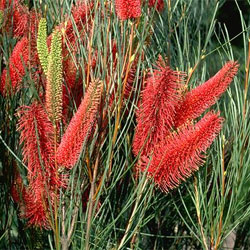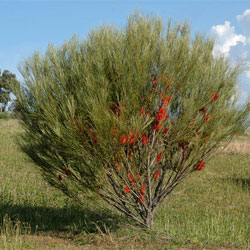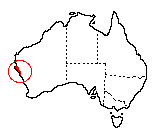Hakea bucculenta
 |
 |
Red Pokers
The genus Hakea includes about 140 species, all endemic to Australia and varying greatly in habit, leaf shape and flower colour. One of the most colourful and distinctive is Hakea bucculenta from Western Australia. This upright narrow-leaved shrub with its tapered orange-red flower spikes 60-100 mm long presents a superb visual effect, and is referred to commonly as Red Pokers.
 In
its natural habitat, the northern sand plains from Geraldton to Shark Bay, H. bucculenta has been recorded as reaching a height of 7 m and flowering
from June to October.
In
its natural habitat, the northern sand plains from Geraldton to Shark Bay, H. bucculenta has been recorded as reaching a height of 7 m and flowering
from June to October.
In cultivation it rarely exceeds 4 m and a fine specimen in the Australian National Botanic Gardens has reached this height in nine years. Buds on this plant form as early as February, and in March green flower spikes develop. These spikes gradually colour and in April a fan-like cluster of flower spikes emerges.
The narrow linear leaves 100-200 mm long with blunt ends extend in an open fashion from the tip right down the length of the stem and are quite graceful. They do not detract from or hide the flower spikes, which are borne on old wood.
Although in the wild it is a prolific seed bearer, in cultivation at the Australian National Botanic Gardens few fruits are formed. These are woody capsules about 22 mm long and 15 mm wide and are closely attached to the stem. The seed is retained on the plant, being released following a bushfire or the death of the plant.
Propagation is easiest from seed which germinates in 3-4 weeks. Cuttings have also been successful but a high percentage strike is rarely obtained.
H. bucculenta appears to be free of insect pests. Both birds and bees are attracted to its flowers. Parrots feed on the flowers, often causing considerable damage; they have also been known to eat the fruits.
Good drainage is essential as the plant is susceptible to the fungus Phytophthora cinnamomi.
H. bucculenta grows well with other shrubs which will tend to provide support from wind, to which it is quite susceptible. A position in full sun produces best flowering and a compact habit whereas growth in shade has a tendency to be sparse with poor flowering.
The species tolerates dry conditions and has proved frost resistant in the Australian National Botanic Gardens.
In spring when new growth appears, a light dressing of a general fertiliser can be given, and the plant will benefit from a mulch of leaf litter or similar mulching material. Care should be taken to ensure the mulch is kept away from the trunk to avoid providing conditions conducive to collar rot.
H. bucculenta is an excellent subject for a feature plant in any garden.
Text by: Nora Ollerenshaw, 1982
RHS Colour Chart. 1966: flowers, red group 50A.
Name meaning: Hakea bucculentaHakea - after Baron von Hake, a German patron of botany; bucculenta - from the Latin, bucca, with full cheeks, probably referring to the swollen sides of the fruit. |
![An Australian Government Initiative [logo]](/images/austgovt_brown_90px.gif)

